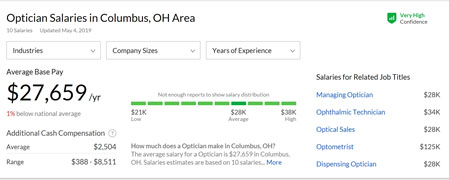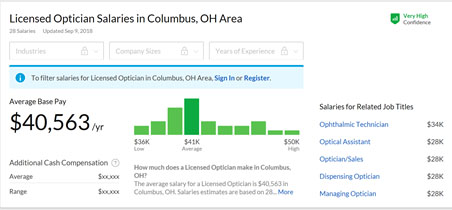By Mark Wright, OD, FCOVD,
and Carole Burns, OD, FCOVD

July 24, 2019
Good help is hard to find, as the expression goes. You want to do everything you can to retain highly performing employees long-term.
One way to do that is by offering a benefits package, in addition to a competitive salary. Here’s how to determine the right benefits to offer your employees, and if you should offer any benefits at all to them.
But first a little history. Prior to the 1930’s there were no employee benefits unless you worked in a dangerous profession like mining, steel or the railroads. Those employees had access to company doctors in industrial clinics or union-operated infirmaries.
After his election in 1932, Franklin D. Roosevelt explored nationalizing healthcare as part of his plan for Social Security, but major opposition from the American Medical Association threatened to doom both initiatives, so he abandoned the idea.
Other Articles to Explore
During the Great Depression, Blue Cross Blue Shield created private health insurance that was purchased almost exclusively by individuals, not employers.
Then, during World War II, the 1942 Stabilization Act was passed in response to America seeing how inflation had devastated the German economy (which gave rise to Hitler’s regime). The goal of the Stabilization Act was to limit employers’ freedom to raise wages to compete for workers. Since employers could not raise wages, they began to offer health benefits as incentives instead.
The 1950’s saw labor unions bargaining for better benefit packages. Vision care became a popular option in 1957, with dental care following in 1959.
Medicare and Medicaid were created by President Johnson in 1965, to address the healthcare issues for retirees and for the economically disadvantaged.
In 1971, Senator Edward Kennedy offered a plan to expand nationalized healthcare to every American. President Nixon had a plan as well. Then, Watergate happened. Healthcare reform took a backseat to other national policy issues until President Bill Clinton brought it back to center stage in 1992. In 1993, his plan died in Congress because it was deemed to be too radical.
High inflation drove a growing number of employers to drop coverage. This led to the creation of HMOs. That led to the creation of other health-care options like PPOs and the rest of the alphabet soup of health-care options we’ve lived with.
In 2010, President Obama signed into law the Patient Protection and Affordable Care Act. The major tenets were that everyone had to purchase healthcare and that every plan had to offer the 10 Essential Health Benefits. The law was challenged and made its way to the Supreme Court where Justice Roberts declared that the law was a tax, and, therefore, constitutional.
Then, the Tax Cuts and Jobs Act of 2017, eliminated the federal tax penalty for violating the individual mandate. In December, a federal district judge in Texas declared that since there was no longer a tax consequence, the law is unconstitutional. The case now sits in the U.S Fifth Circuit Court of Appeals on its way back to the Supreme Court.
No matter how the Supreme Court ultimately rules on the case, the core question for employers is still the same – how to compete for workers.
The first step is to make sure you are in compliance with employment laws. Your practice attorney and your practice CPA can help you with this.
The next step is to offer a competitive wage-benefits package. The best way to determine this is to find out what others are paying for the same type of work. You can do this by obtaining salary data. Here are some of these tools which give us data by area and occupation.
• The U.S. Bureau of Labor Statistics
• Jobson ECP Income Study
• Glassdoor.com
• Salary.com
• Payscale.com
• Monster.com
A simple search in glassdoor.com for opticians in Columbus, Ohio, returned the following informationiii:
Another search run at the same site (glassdoor.com) for licensed opticians returned this information:
Make sure you are comparing apples to apples when you do a search.
The MBA data told us the overall compensation package in a standard eyecare practice for non-doctor, non-in house optical laboratory staff should not be higher than 20-22 percent of gross revenue collected, with the average being in the 15-17 percent range.
One helpful way to consider all of this data together is to start with 22 percent of gross revenue collected. That is the highest bucket of money you have to purchase your non-doctor, non-in house optical laboratory staff. When you add up wage + bonus + benefits for all your staff, it should not exceed the maximum of 22 percent. If it does, then the problem is generally either a staff productivity issue or staff members asking for more money than the job should pay.
The economy also matters. Right now, the unemployment rate is low. That means it will cost you more to keep employees because it’s hard to find new employees.
Perception is reality. Many people only focus on the wage instead of the total package. To be competitive, it’s important to understand the total package. One way to do this is to create a document for each of your current and potential staff explaining each benefit offered with a specific numerical value beside each benefit. Then, show the wage and potential bonus. Add up all the numbers to show the total value of working for you.
References
i. https://www.griffinbenefits.com/employeebenefitsblog/history-of-employer-sponsored-healthcare
ii. https://www.bls.gov/bls/blswage.htm
iii. https://www.glassdoor.com/Salaries/columbus-optician-salary-SRCH_IL.0,8_IM196_KO9,17.htm





























